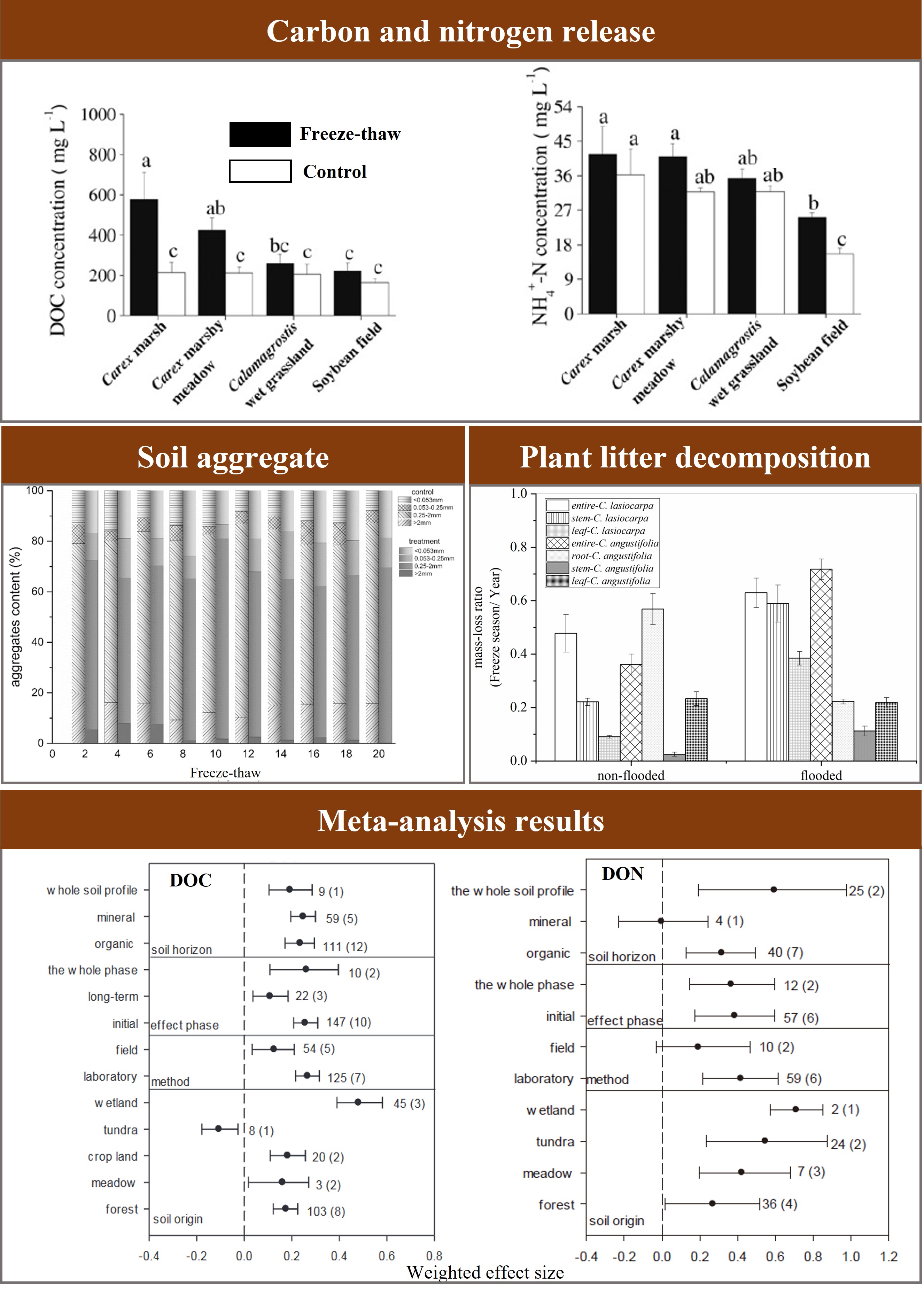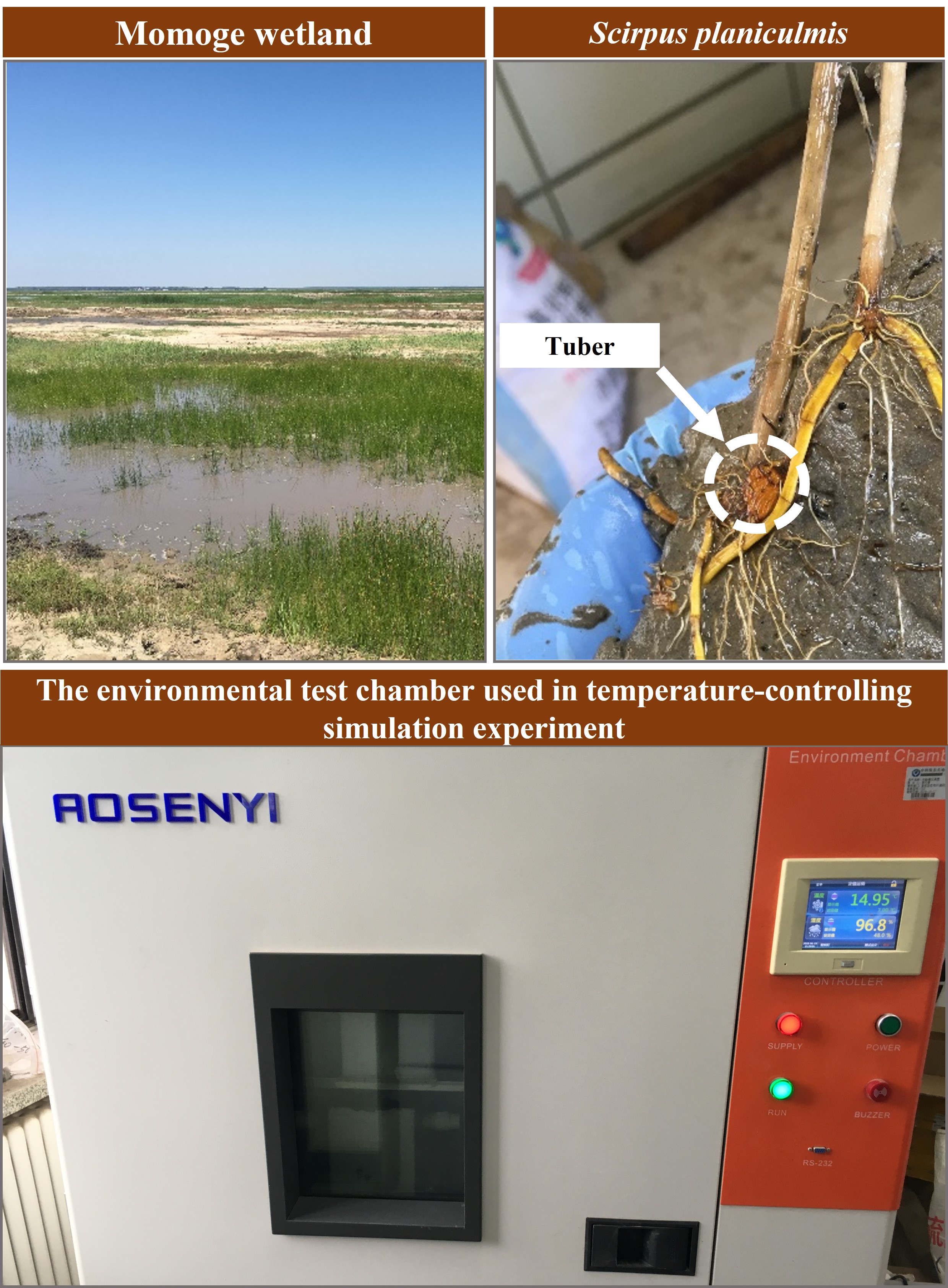Freeze-thaw cycles alter the growth sprouting strategy of wetland plants by promoting denitrification
Published in Ecology & Evolution

Freeze-thaw cycles, though short in duration throughout the year, have a great influence on ecosystem functions and processes, which are considered critical abiotic stresses. Numerous studies have advanced our knowledge of freeze-thaw cycles’ ecological effects on soil biogeochemical cycles and their mechanisms in various ecosystems, such as farmland, forest, and tundra.
In recent years, our research team has conducted studies on freeze-thaw cycles’ ecological effects on boreal wetlands, which are seen as important terrestrial carbon and nitrogen pools and are susceptible to freeze-thaw cycles. Through case studies, we found that freeze-thaw cycles could prompt substantial releasing of carbon and nitrogen, change the migration of nutrients 1, 2, 3, 4, 5, 6, and alter aggregate stability in wetland soil 7. Furthermore, wetland litter decomposition during frozen and freeze-thaw periods accounts for more than half of the annual decomposition 8. Through a meta-analysis, we quantified and compared the effects of freeze-thaw cycles on carbon and nitrogen cycles in different ecosystems and discovered that freeze-thaw cycles prompt wetlands to release more organic carbon and nitrogen than other ecosystems 9 (Fig. 1).

Fig. 1 Discoveries in our previous studies.
Based on these findings, we summarized and pondered our research and realized that, like most studies, we focused on the freeze-thaw’s immediate effects, with sampling occurring during or at the end of the freeze-thaw period, but overlooked something important: how plants, soil, and microbial communities change after the freeze-thaw period. As for boreal wetlands, plants resprouting after winter dormancy suggest that changes in environmental conditions caused by the freeze-thaw period might be important for the establishment and succession of wetland plant communities. Therefore, we proposed two scientific questions to explore in future works: 1) Do freeze-thaw cycles have carry-over effects on wetland soil nutrients in the early growing season? What is the related microbial mechanism? 2) Do freeze-thaw cycles have carry-over effects on wetland plant sprouting and early growth? What are the wetland plant adaptation strategies?
Subsequently, we conducted a temperature-controlling simulation experiment under two freeze-thaw (freeze-thaw, control) and two flooding conditions (non-flooding, flooding) on a typical plant (Scirpus planiculmis) and soil from the Momoge wetland (China) and analyzed the microbial nitrogen metabolism, based on metagenomic sequencing (Fig. 2).

Fig. 2 Material collection and preparation.
After the experiment and data analysis, three main outcomes were obtained: 1) Freeze-thaw’s carry-over effects strengthened denitrification and resulted in soil nitrogen reduction, thereby enhancing wetland nitrogen limitation and inhibiting plant sprouting and early growth. 2) Wetland plant adjusted its sprouting strategies to adapt to the enhanced nitrogen limitation. 3) Flooding could alleviate the freeze-thaw’s carry-over effects. These outcomes were summarized in a conceptualized bullet model (Fig. 3).

This recent paper suggests that wetland plants in mid-to-high latitudes have evolved sprouting and growth strategies to adapt to climatic conditions at the beginning of winter and spring, enriching the theoretical research on wetland ecological processes and functions. It will aid in the accurate assessment of climate change’s effects on wetlands and can also be applied to nitrogen management and productivity improvements in wetlands.
Acknowledgements
This research was funded by the National Natural Science Foundation of China (grant numbers 42222102, 42171107), and the Professional Association of the Alliance of International Science Organizations (Grant No. ANSO-PA-2020-14).
References:
- Yu X. Material Cycling of Wetland Soils Driven by Freeze-Thaw Effects (Springer Berlin, Heidelberg, 2013).
- Yu, X., Zou, Y., Jiang, M., Lu, X. & Wang, G. Response of soil constituents to freeze–thaw cycles in wetland soil solution. Soil Biol. Biochem.43, 1308–1320 (2011).
- Yu, X., Wang, G. Field simulation the effects of global warming on the freeze-thaw process of the freshwater marsh in the Sanjiang Plain, Northeast China. In: International Conference on Bioinformatics and Biomedical Engineering) (2008).
- Yu, X., Song Y., Zou, Y., Jiang, M., Lu, X., Wang, G. Does warming influence freeze-thaw treated dissolved in wetland soil solutions. Fresenius Environ Bull 25, 2220-2224 (2016).
- Yu, X., Zhang Y., Zhao H., Lu X., Wang G. Freeze-thaw effects on sorption/desorption of dissolved organic carbon in wetland soils. Chin Geogr Sci 20, 209-217 (2010).
- Yu X., Zhang Y., Zou Y., Zhao H., Lu X., Wang G. Adsorption and desorption of ammonium in wetland soils subject to freeze-thaw cycles. Pedosphere 21, 251-258 (2011).
- Song, Y., Zou, Y., Wang, G. & Yu, X. Stimulation of nitrogen turnover due to nutrients release from aggregates affected by freeze-thaw in wetland soils. Phys. Chem. Earth97, 3–11 (2017).
- Yu, X. et al. Wetland plant litter decomposition occurring during the freeze season under disparate flooded conditions. Sci. Total Environ.706, 136091 (2020).
- Song, Y., Zou, Y., Wang, G. & Yu, X. Altered soil carbon and nitrogen cycles due to the freeze-thaw effect: a meta-analysis. Soil Biol. Biochem.109, 35–49 (2017).
Follow the Topic
-
Communications Earth & Environment

An open access journal from Nature Portfolio that publishes high-quality research, reviews and commentary in the Earth, environmental and planetary sciences.
Related Collections
With Collections, you can get published faster and increase your visibility.
Geology of the Moon
Publishing Model: Hybrid
Deadline: Jan 31, 2026
Drought
Publishing Model: Hybrid
Deadline: Dec 31, 2025




Please sign in or register for FREE
If you are a registered user on Research Communities by Springer Nature, please sign in